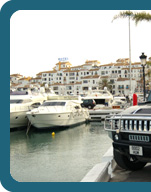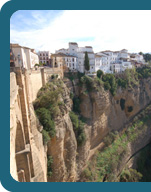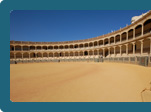| |
|
 |
|
|
|
 |
| Marbella |
 |
 |
If you're looking for a synonym for luxury, Marbella always ends up high on the list. Indeed, the Spanish haute monde has always vacationed in Marbella, be it film stars, bankers or politicians - and always accompanied by the yellow press.
But the international jet set, too, has been coming together here for decades, the monied aristocracy as well as the old one, stars of the very first league. Throughout Spain there is no other place where so many notables gather during summer. Marbella itself has admittedly stayed a small location with a pretty old town, but has mightily expanded. Across 26 km streches a zone that today is considered to be the Greater Marbella area.
To the west and east of the actual city there are uncountable urbanizaciones and hotel facilities. And somewhere in between, luxury hotels, private villas and strictly sealed off clubs exist, in which the a-list sojourns. The VIPs stay among themselves. Marbella is said to have 28 km of beach – that of course is only true for the greater area, the heart of the town is considerably smaller. |
|
|
| |
Worth seeing |
|
|
| |
In the old quarter of Casco Viejo, Marbella's beauty has survived. The narrow alleys and pretty white houses are being lovingly cared for. In the maze of the alleys one can blissfully wander around without aim. Ordinary tenements as well as luxury shops, rustic bodegas and 'tourist traps' can be found here.
Indeed, this maze of alleys still reminds a little of the Moorish past, even if not very distinctly. Some of these alleys are maybe one metre in width, others are barely wide enough for a car to fit through. It's very nice, cosy and exceedingly interesting thanks to the many different shops and bars.
|
|
|
| |
Old town |
|
|
| |
Virtually a neuralgic point within the old town is the Plaza de los Naranjos. Actually it is a truly beautiful piazza, in whose middle, like the name suggests, there are orange trees, together with a well from 1604.
This is also where the townhall (ayuntamiento) stands, a building that dates from the year 1572 and features beautiful architectonic details, like for example the balcony; the fresco paintings are admirable, too. In the building a tourist information is housed. On the other side of the square stands the Ermita de Nuestro Senor Santiago, a small chapel from the 15th cent.
It was the first place of worship to be erected after the city's reconquest by the Spaniards. The building Casa del Corregidor with its striking facade was built in the 16th cent. | |
|
| |
Puerto Banús |
|
|
| |
The world-famous yacht harbour Puerto Banús is without doubt the biggest sight of the town. Situated a few kilometres west of Marbella, this place has been spared from hotel giants, and the houses have been built Moorish-style at least to some extent. The surrounding beaches are well-frequented but not jam-packed. If you don't like to lie on the beach around midday heat, you can go for a stroll on the nice promenade and enjoy some culinary delicacies at one of the many restaurants.
|
 |
 |
| |
The actual eyecatcher in Puerto Banús are unquestionably the yachts, though.Where else do you get to see motorboats 25 to 40 metres long and with three to four decks, served by no less than a dozen staff members? The public gathers on the promenade, marvelling at the brilliant white giants. If you are more interested in onshore means of transportation, however, there will be something for you to look at as well, since huge yachts usually go with luxurious cars. Therefore its almost needless to say that corresponding cars park in front of the ships, red Ferraris, Hummers, Bentleys etc. On the whole southern coast of Spain you won't find as much wealth gathered in one place as here. |
 |
 |
| |
Ronda |
|
|
| |
Ronda is a picturesque city situated amidst the mountains at a level of 750 metres. The drive up from the coast has already a few sights to offer. Ronda is located on a plateau and is divided in two by a canyon nearly 100 metres deep. The Rio Guadalevin and the three-arched bridge Puente Nuevo, which connects the two districts in architectural mastery, enclose the city. The older borough dates from Moorish times and still features some remains. It's called tersely 'La Ciudad' ('The city').
|
 |
 |
| |
Located on the other side is the newer neighbourhood El Mercadillo, with the oldest bullfighting arena in Spain. Both boroughs have been able to preserve their antique charm, having been spared widely from modern innovations. For that reason they give an insight into not only the Moorish period but also into the times when Christian conquerors entered the city. |
 |
 |
| |
|
|
|
| |
 |
|
| |
|
|
|
|